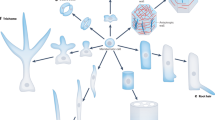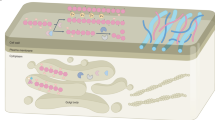Abstract
The growing plant cell wall is commonly considered to be a fibre-reinforced structure whose strength, extensibility and anisotropy depend on the orientation of crystalline cellulose microfibrils, their bonding to the polysaccharide matrix and matrix viscoelasticity1–4. Structural reinforcement of the wall by stiff cellulose microfibrils is central to contemporary models of plant growth, mechanics and meristem dynamics4–12. Although passive microfibril reorientation during wall extension has been inferred from theory and from bulk measurements13–15, nanometre-scale movements of individual microfibrils have not been directly observed. Here we combined nanometre-scale imaging of wet cell walls by atomic force microscopy (AFM) with a stretching device and endoglucanase treatment that induces wall stress relaxation and creep, mimicking wall behaviours during cell growth. Microfibril movements during forced mechanical extensions differ from those during creep of the enzymatically loosened wall. In addition to passive angular reorientation, we observed a diverse repertoire of microfibril movements that reveal the spatial scale of molecular connections between microfibrils. Our results show that wall loosening alters microfibril connectivity, enabling microfibril dynamics not seen during mechanical stretch. These insights into microfibril movements and connectivities need to be incorporated into refined models of plant cell wall structure, growth and morphogenesis.
This is a preview of subscription content, access via your institution
Access options
Access Nature and 54 other Nature Portfolio journals
Get Nature+, our best-value online-access subscription
$29.99 / 30 days
cancel any time
Subscribe to this journal
Receive 12 digital issues and online access to articles
$119.00 per year
only $9.92 per issue
Buy this article
- Purchase on Springer Link
- Instant access to full article PDF
Prices may be subject to local taxes which are calculated during checkout



Similar content being viewed by others
Change history
26 November 2020
A Correction to this paper has been published: https://doi.org/10.1038/nplants.2017.56.
References
Burton, R. A., Gidley, M. J. & Fincher, G. B. Heterogeneity in the chemistry, structure and function of plant cell walls. Nat. Chem. Biol. 6, 724–732 (2010).
Baskin, T. I. Anisotropic expansion of the plant cell wall. Annu. Rev. Cell Dev. Biol. 21, 203–222 (2005).
Cosgrove, D. J. Growth of the plant cell wall. Nat. Rev. Mol. Cell Biol. 6, 850–861 (2005).
Bidhendi, A. J. & Geitmann, A. Relating the mechanics of the primary plant cell wall to morphogenesis. J. Exp. Bot. 67, 449–461 (2016).
Louveaux, M., Julien, J. D., Mirabet, V., Boudaoud, A. & Hamant, O. Cell division plane orientation based on tensile stress in Arabidopsis thaliana. Proc. Natl Acad. Sci. USA 113, E4294–E4303 (2016).
Sampathkumar, A. et al. Subcellular and supracellular mechanical stress prescribes cytoskeleton behavior in Arabidopsis cotyledon pavement cells. eLife 3, e01967 (2014).
Braybrook, S. A. & Jonsson, H. Shifting foundations: the mechanical cell wall and development. Curr. Opin. Plant Biol. 29, 115–120 (2016).
Peaucelle, A. et al. Pectin-induced changes in cell wall mechanics underlie organ initiation in Arabidopsis. Curr. Biol. 21, 1720–1726 (2011).
Kierzkowski, D. et al. Elastic domains regulate growth and organogenesis in the plant shoot apical meristem. Science 335, 1096–1099 (2012).
Bassel, G. W. et al. Mechanical constraints imposed by 3D cellular geometry and arrangement modulate growth patterns in the Arabidopsis embryo. Proc. Natl Acad. Sci. USA 111, 8685–8690 (2014).
Yanagisawa, M. et al. Patterning mechanisms of cytoskeletal and cell wall systems during leaf trichome morphogenesis. Nat. Plants 1, 15014 (2015).
Nakayama, N. et al. Mechanical regulation of auxin-mediated growth. Curr. Biol. 22, 1468–1476 (2012).
Preston, R. D. The case for multinet growth in growing walls of plant cells. Planta 155, 356–363 (1982).
Suslov, D., Verbelen, J. P. & Vissenberg, K. Onion epidermis as a new model to study the control of growth anisotropy in higher plants. J. Exp. Bot. 60, 4175–4187 (2009).
Anderson, C. T., Carroll, A., Akhmetova, L. & Somerville, C. Real-time imaging of cellulose reorientation during cell wall expansion in Arabidopsis roots. Plant Physiol. 152, 787–796 (2010).
Hepworth, D. G. & Bruce, D. M. Relationships between primary plant cell wall architecture and mechanical properties for onion bulb scale epidermal cells. J. Texture Stud. 35, 586–602 (2004).
Wilson, R. H. et al. The mechanical properties and molecular dynamics of plant cell wall polysaccharides studied by Fourier-transform infrared spectroscopy. Plant Physiol. 124, 397–405 (2000).
Zhang, T., Zheng, Y. & Cosgrove, D. J. Spatial organization of cellulose microfibrils and matrix polysaccharides in primary plant cell walls as imaged by multichannel atomic force microscopy. Plant J. 85, 179–192 (2016).
Burgert, I. & Keplinger, T. Plant micro- and nanomechanics: experimental techniques for plant cell-wall analysis. J. Exp. Bot. 64, 4635–4649 (2013).
Park, Y. B. & Cosgrove, D. J. A revised architecture of primary cell walls based on biomechanical changes induced by substrate-specific endoglucanases. Plant Physiol. 158, 1933–1943 (2012).
Cosgrove, D. J. Catalysts of plant cell wall loosening. F1000Research 5, 119 (2016).
Yuan, S., Wu, Y. & Cosgrove, D. J. A fungal endoglucanase with plant cell wall extension activity. Plant Physiol. 127, 324–333 (2001).
Schopfer, P. Biomechanics of plant growth. Am. J. Bot. 93, 1415–1425 (2006).
Hamant, O. & Traas, J. The mechanics behind plant development. New Phytol. 185, 369–385 (2010).
Greaves, G. N., Greer, A. L., Lakes, R. S. & Rouxel, T. Poisson's ratio and modern materials. Nat. Mater. 10, 823–837 (2011).
Marga, F., Grandbois, M., Cosgrove, D. J. & Baskin, T. I. Cell wall extension results in the coordinate separation of parallel microfibrils: evidence from scanning electron microscopy and atomic force microscopy. Plant J. 43, 181–190 (2005).
Fayant, P. et al. Finite element model of polar growth in pollen tubes. Plant Cell 22, 2579–2593 (2010).
Park, Y. B. & Cosgrove, D. J. Xyloglucan and its interactions with other components of the growing cell wall. Plant Cell Physiol. 56, 180–194 (2015).
Milani, P., Braybrook, S. A. & Boudaoud, A. Shrinking the hammer: micromechanical approaches to morphogenesis. J. Exp. Bot. 64, 4651–4662 (2013).
Eichhorn, S. J. Stiff as a board: perspectives on the crystalline modulus of cellulose. ACS Macro Lett. 1, 1237–1239 (2012).
Spatz, H., Kohler, L. & Niklas, K. J. Mechanical behaviour of plant tissues: composite materials or structures? J. Exp. Biol. 202, 3269–3272 (1999).
Cleland, R. E. The instron technique as a measure of immediate-past wall extensibility. Planta 160, 514–520 (1984).
Abasolo, W. et al. Pectin may hinder the unfolding of xyloglucan chains during cell deformation: implications of the mechanical performance of Arabidopsis hypocotyls with pectin alterations. Mol. Plant. 2, 990–999 (2009).
Cleland, R. A separation of auxin-induced cell wall loosening into its plastic and elastic components. Physiol. Plant. 11, 599–609 (1958).
Thevenaz, P., Ruttimann, U. E. & Unser, M. A pyramid approach to subpixel registration based on intensity. IEEE Trans. Image Process 7, 27–41 (1998).
Xu, T. et al. SOAX: a software for quantification of 3D biopolymer networks. Sci. Rep. 5, 9081 (2015).
Acknowledgements
This work was supported as part of the Center for LignoCellulose Structure and Formation, an Energy Frontier Research Center funded by the US Department of Energy, Office of Science, Basic Energy Sciences under award no. DE-SC0001090. D.V. was supported by NIH grant R01GM098430. We thank E. Wagner, X. Wang, S. Kiemle and Y. B. Park for technical assistance.
Author information
Authors and Affiliations
Contributions
T.Z. carried out the AFM experiments and analysed the data. D.V. assisted with SOAX analysis of microfibril orientations. D.M.D. designed and built the AFM extensometer. D.J.C. designed the research and analysed the data. T.Z., D.J.C. and D.V. wrote the manuscript.
Corresponding author
Ethics declarations
Competing interests
The authors declare no competing financial interests.
Supplementary information
Supplementary Information
Supplementary Figures 1-5, Legends for Supplementary Videos 1-4. (PDF 683 kb)
Supplementary Video 1
Animated GIF showing negligible microfibril movement during Cel12A-induced stress relaxation. (GIF 428 kb)
Supplementary Video 2
Animated GIF to compare microfibril positions before and after plastic extension. (GIF 716 kb)
Supplementary Video 3
Animated GIF showing microfibril movement during elastic extension. (GIF 686 kb)
Supplementary Video 4
Animated GIF showing microfibril movement during Cel12A-induced creep. (GIF 695 kb)
Rights and permissions
About this article
Cite this article
Zhang, T., Vavylonis, D., Durachko, D. et al. Nanoscale movements of cellulose microfibrils in primary cell walls. Nature Plants 3, 17056 (2017). https://doi.org/10.1038/nplants.2017.56
Received:
Accepted:
Published:
DOI: https://doi.org/10.1038/nplants.2017.56
This article is cited by
-
Structure and growth of plant cell walls
Nature Reviews Molecular Cell Biology (2023)
-
Gradient variations of cellulose supramolecular structures in moso bamboo culm: from nano- to microhorizons
Wood Science and Technology (2023)
-
Carbohydrate-aromatic interface and molecular architecture of lignocellulose
Nature Communications (2022)
-
Preferred crystallographic orientation of cellulose in plant primary cell walls
Nature Communications (2020)
-
Automated Tracking of Biopolymer Growth and Network Deformation with TSOAX
Scientific Reports (2019)



